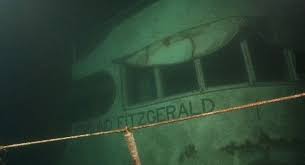And who doesn’t know the mournful song by Gordon Lightfoot? This is quite a fascinating article.

By the day he died, Ernest McSorley had built a reputation as the captain who could weather any storm. He was one of the best sailors on the Great Lakes, where he had been assigned to pilot the Edmund Fitzgerald, the flagship of Oglebay Norton’s Columbia Transportation Division. At 729 feet long, the American freighter was among the largest ships in the region. McSorley prided himself on his efficiency, and he always delivered his cargo on time, navigating skillfully through dangerous waters.
**********************
Despite his decades of experience, McSorley reported over the radio that he was witnessing “one of the worst seas I’ve ever been in.” Just after 7 p.m., the Anderson checked in again and asked how the Fitzgerald was faring. “We are holding our own,” the captain said.
After that final transmission, the Fitzgerald stopped answering calls from the Anderson and disappeared from the radar. Without ever sending out a distress signal, the ship went down about 17 miles (15 nautical miles) from safety, taking all 29 crew members with it.
Fifty years after the Fitzgerald slipped beneath the surface of Lake Superior, the tragedy has become deeply embedded in the popular imagination. While its death toll is eclipsed by those of calamities like the Titanicand the Lusitania, and its journey lacks the grand adventure arc associated with expeditions like John Franklin’s failed quest to discover the Northwest Passage, the doomed freighter easily ranks among history’s most famous shipwrecks. Known as the “Titanicof the Great Lakes,” the vessel is a reminder of maritime disasters’ enduring power to captivate, regardless of their scale.
***************************

Nobody knows exactly how many shipwrecks lie beneath the lakes’ waters. Bacon estimates that between 1875 and 1975, a total of 6,000 commercial wrecks killed roughly 30,000 mariners—which amounts to about one death per day for 100 years. Of those 6,000 shipwrecks, the Fitzgerald is the most notorious. It’s also the last.
Since 1975, there haven’t been any major industrial wrecks on the Great Lakes. What changed? Advances in weather forecasting and communication technologies have certainly done their part to keep ships afloat. But so have evolving norms in commercial shipping. The Fitzgerald’s downfall sent “shock waves through the whole industry,” says Bacon. “It was so cataclysmic that they finally woke up.” Bacon was at Lake Superior last November, and when the weather turned angry, “every single ship was anchored in Whitefish Bay,” he says. “And 50 years ago, trust me, none of them would’ve been.”
Leave a Reply